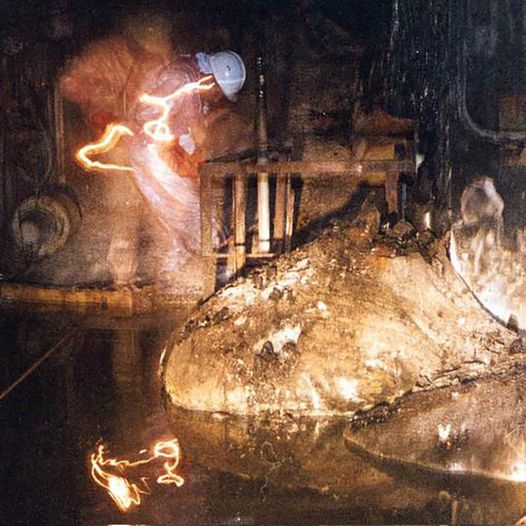Η φωτογραφία του Artur Korneyev του Elephant’s Foot, 1996. Το Elephant’s Foot είναι το παρατσούκλι που δόθηκε σε μια μεγάλη μάζα κορίου και άλλων υλικών που σχηματίστηκε κάτω από τον πυρηνικό σταθμό του Τσερνομπίλ, κοντά στο Pripyat, κατά τη διάρκεια της καταστροφής του Τσερνομπίλ τον Απρίλιο του 1986, που είναι αξιοσημείωτο για την ακραία ραδιενέργεια του . Ανακαλύφθηκε τον Δεκέμβριο του ίδιου έτους, βρίσκεται σε ένα διάδρομο συντήρησης κοντά στα υπολείμματα του αντιδραστήρα Νο. 4. Είναι ακόμα ένα εξαιρετικά ραδιενεργό αντικείμενο, αν και ο κίνδυνος μειώθηκε με την πάροδο του χρόνου λόγω της αποσύνθεσης των ραδιενεργών συστατικών του. Περισσότερες σπάνιες φωτογραφίες από την καταστροφή του Τσερνομπίλ: https://bit.ly/3OYsy9S





A photo from a home archive. Probably never published anywhere before. My father filming the remains of the Reactor 4 in 1986
https://imgur.com/a/Ng4OvuJ
i watch the series Chernobyl, and i open fb and this appeared on facebook. Creppy
This haunts me every time. It looks like a monster, the scariest of them all.
Matt Hancock
Chris McGhie
What about the Flash beside it? Is it Jay Garrick?
Is that a guitar
Has anyone gone back recently since then and taken pics? With protective gear of course.
I was learn that this mass could even contain melted concrete, is it true?
It looks like it’s running through that person with the hard hat on
Poor buggers in there😓
Take a bow to those brave men!
It couldn’t have been possible to have unprotected workers in the room. Unless it is moments before death
i like the comment about the radioactivity has decreased and is not as dangerous as it was. the half life for Uranium radioactivity is 10,000 years
Old mate looks like he’s being taken by the ghostbusters
Initially I thought there was just a hard hat hanging on the wall.. but then upon closer inspection, I saw two ghostly images of two men. The radiation must have been so high they looked transparent. That’s scary! I also heard that the robotic camera sent in had melted before it could take photographs of the “Elephant’s Foot”, so they had to hide around the corner and use mirrors. It will be 100’s of years or longer before this area is deemed safe.
Idk about you but all I see is a deer wearing a hard hat on its antlers
Is that a guy standing there with no suit or any protective gear ?!?!?!
Correction… 2 guys ?!?!
Curium has half-live of 15,6 Million years… not so sure the danger has decreased at all by now
How were they even able to photograph it
Was buckethead shredding in the USSR?
Back in 1990 when I was studying nuclear medicine one of my instructors was one of the first radiation safety officers to go into Chernobyl. The radiation was so high that even with all of the protection they were wearing, they were only allowed in for 15 minutes in a 24hr period due to the amount of exposure.
The liquidators that went to Chernobyl to put out the fires and contain the radioactive material probably had no idea how brave they were. Too bad the Soviet government covered everything up, including probably the effects of being exposed to the radiation with mostly inadequate protection. The people involved in the initial 1986 cleanup were true heroes.
When it was formed, the amount of radiation was enough to kill a healthy person (standing in front of it) in a matter of five minutes.
Those men pictured at the background are likely dead by now. It’s a shame their government saw them as dispensable
Such a horrific disaster at the time. I wanted to see it in person though. In 2017 I did a tour of Chernobyl. The tour guide made note of bringing a gamma detector and showing us the gamma detector readings in Kiev (.17 if I believe) and again in Chernobyl. Chernobyl had lower readings (.11 I beleive) thanks to the liquidators following the disaster. Pripyat, is another story. Theres still spots, especially by the river where materials are 1000x the “healthy” exposure limit. Seeing a once thriving industrial city taken over nature was a surreal experience to say the least!
Fun fact as well about this photo; it was taken on a mirror with a camera mounted round the corner, because the wheeled camera they initially sent in to take photos was destroyed by the sheer amount of radiation from this thing.
I never understood why my parents had such a negative view of the USSR. Now that I’m older, I’m starting to get used to it. What was done at Chernobyl was criminal, what was done to cover it up was unconscionable. How many thousands of people suffered and died worse than necessary just because the USSR tried to keep up appearances?
Chernobyl Disaster through photos:
https://rarehistoricalphotos.com/chernobyl-disaster-pictures-1986/